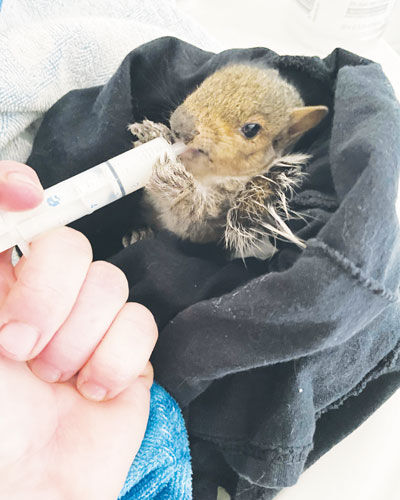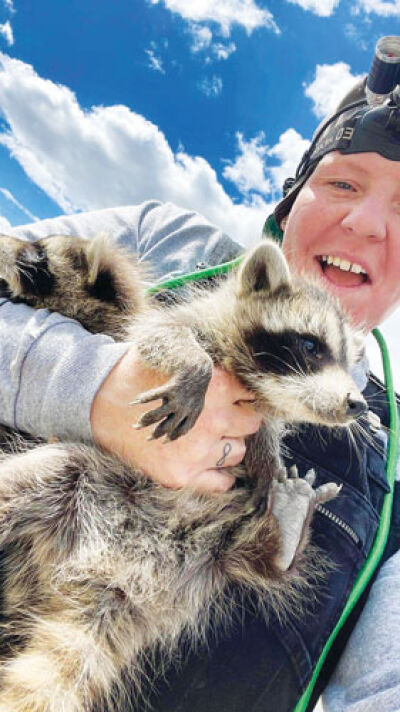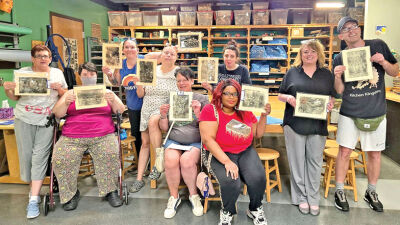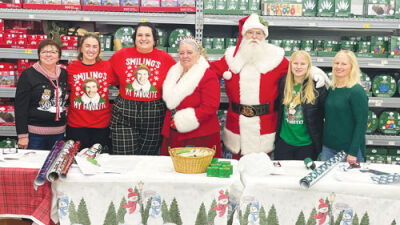
Kim Walton nurses a baby squirrel. Young abandoned animals are another situation she encounters.
Photo provided by Kim Walton

A former animal control officer who now works independently helping people relocate wildlife from their homes, Kim Walton holds two raccoons she rescued. The animals are safely relocated to undeveloped land where they’re provided food to get settled.
Photo provided by Kim Walton
STERLING HEIGHTS — For more than 10 years, Kim Walton served as the animal control officer for Sterling Heights, Warren and Eastpointe. She enforced animal welfare laws, taught the public about pet safety and found homes for strays at the shelter.
She retired in 2023. Since then, she’s continued to put her wildlife expertise to good use. Whether it’s squirrels in the attic, birds in the chimney, or the live trap removal of groundhogs, skunks and rats causing mischief in the yard, her goal is to relocate each animal without harming it, and then ensure they thrive in their new environment.
“I always enjoyed the wildlife calls at animal control — things like a squirrel running around someone’s house, a raccoon in a fireplace. I was always fascinated by nondomestic animals,” Walton said. “I loved what I did as an animal control officer and knew I was making a difference. But I think it took a toll on me mentally over the years. I was very passionate and had a hard time turning it off. I thought about work constantly: the shelter animals that needed to be placed, the court hearings, the abuse cases.”
In 2021, two years before she retired, she started to refocus. She came up with the concept of Compassionate Critter Removal, a venture she found invigorating.
“I wanted to provide a humane option for critter removal,” Walton said.
She had already seen so much as an animal control officer. In her previous role, she would regularly receive calls from distressed residents in each town.
“They’d range from injured wildlife to found baby squirrels, raccoons, rabbits, groundhogs — sometimes in people’s homes,” Walton said. “That gave me a chance to familiarize myself with various types of wildlife, to learn their behaviors. I was also able to form contacts with local wildlife rehabbers that I still use today.
“What you see really depends on the time of year. Each species has a baby season, and that’s when problems arise,” she said. “For example, raccoons typically start having babies in March. Around this time, they’re desperate to find nesting places, and the most common places they get into are uncapped chimneys, fireplaces and attics. We also get them under homes, down in crawl spaces. It’s common for them to go undetected prior to the babies making noise.”
To that end, many issues can be avoided with a bit of due diligence.
“I often tell people to do a monthly inspection of their home,” Walton said. “Always check for missing or compromised chimney caps, missing soffit pieces, falling shingles, paw prints on down spouts and digging near the house. Always cut back any trees touching the roof — once critters have a segue to the roof, trouble starts.”
Sometimes the calls are especially urgent.
“I get a few ‘911’ calls, like one last year in Grosse Pointe where a man woke up with a raccoon in his bed. He was able to confine it in a closet until we could arrive,” Walton said. “We also get situations where animals are injured, sick or stuck in something like a fence or car engine.
“Being able to confine the animal is always best, but if you’re not able to do that or aren’t comfortable with that, keep an eye on it — that way when someone gets there, they can locate it,” Walton said. “It’s important to remember these are wild animals that can carry disease. But they’re usually just as scared as us and want nothing to do with us.”
She described Compassionate Critter Removal as something of an “odd niche.”
“I oftentimes feel guilty for having to relocate the animals. I try and combat that by relocating them to the most ideal area for each species. We relocate them to properties where we drop off food multiple times a week. This provides a good source while they settle into a new area,” Walton said.
“The cages are wrapped in tarps to help the animal feel safe and less exposed. This also helps shelter them from the elements,” she said. “I use specific bait for each species. If it’s hot, we have water crocs that get attached to cages and provide hydrating bait. If it’s cold, I put a towel in the traps so the animals can warm up.
“But I still feel guilty having to relocate them,” she said. “The reality is us humans are taking away all their homes and land. On top of that, you have people ground feeding them, which draws unwanted critters into residential spaces, and that creates an overabundance of animals. I just have to remind myself that I’m doing necessary work. The goal is to remove the animals as humanely and compassionately as possible.”
Among the many kindred spirits Walton has worked with over the years is Julie Tirony, cofounder of the no-kill rescue Animal House of South East Michigan.
“What I admired most about Kim as an animal control officer is how for her, it wasn’t just a job; she made a point of networking to get animals out of the holding space they had in Sterling Heights. The shelter there is very small, with only a certain amount of time before they’re transferred to the county where they might be put down,” Tirony said. “She compiled a list of rescues over the years and would ‘spread the love,’ as I called it — going down the line, asking if a rescue can take two cats here or there, and if they couldn’t, maybe the next rescue could. She’d do this to save them all.
“Not all animal control officers are like that. Even the ones who care get compassion fatigue, where they feel exhausted from caring so much, and they might not put in the same effort,” she said. “It’s not an easy way to do the job. But Kim believes in doing whatever she can to help.”
Walton said those interested in a career helping animals should follow their passion.
“I think there’s a growing interest — people see animals very differently than 20, 30 years ago. They see their emotions, and they have empathy,” Walton said. “So whether you want to advocate for them in animal control, help at a rescue or become a veterinarian, the animals need you.”
 Publication select ▼
Publication select ▼





















